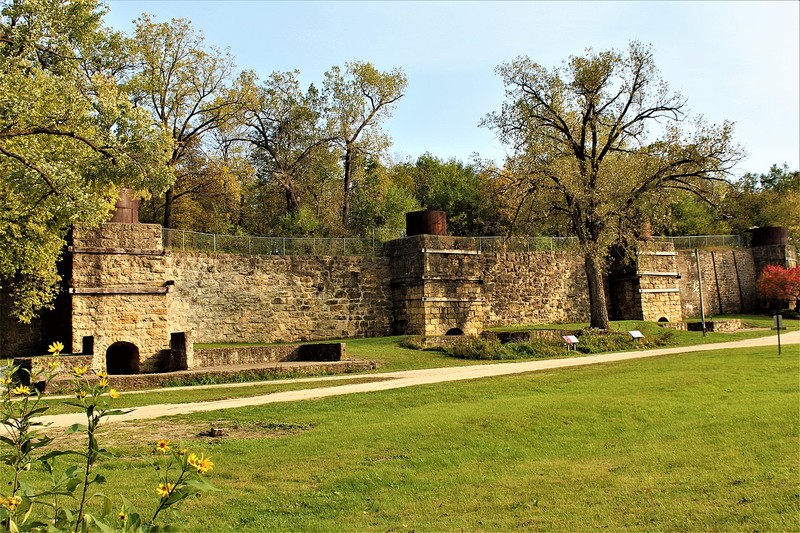Hurstville Lime Kilns
Introduction
Text-to-speech Audio
Between 1871 and 1920, the Hurstville Lime Kilns was one of the largest producers of lime in the country. Once the centerpiece of a large complex and company town called Hurstville, it appears that the four restored lime kilns are all that remain. Before concrete was invented, lime powder, which adheres well to brick, was an essential ingredient in construction. The kilns was established in 1870 by businessman and politician Alfred Hurst, who recognized the high quality of the limestone located here along the Maquoketa River. The site, which is listed on the National Register of Historic Places as the Hurstville Historic District, includes a large parking area and two interpretive signs that provide information about kilns' history. It is owned by the Jackson County Historical Society.
Images
For several decades, these four historic kilns produced enormous amounts of lime powder that was used throughout the midwest.

Backstory and Context
Text-to-speech Audio
Alfred Hurst immigrated to the United States from England and served in the Civil War. He also served as county supervisor and as state senator. He arrived in Maquoketa in 1870 and learned of the limestone deposits along the river. He built a small kiln and in 1871 built the four existing large kilns. That year the kilns produced 3,200 barrels of lime powder. Workers collected the limestone rock from the site's quarry and unloaded it at the top of kilns where fires broke it down into powder, which was then collected at the base of the kilns. At construction sites, the lime was mixed with sand and water to make mortar.
The fires required enormous amounts of wood, which was taken from the land the company owned. At its height, the company owned 3,000 acres of land and produced 8,000 barrels each day. After the Maquoketa and Hurstville Railroad, which Hurst established, arrived in 1888, the company shipped lime to market much faster. The workers were paid $1.25 per day in 1899, which was quite high for the time considering that rent was $3.00 a month. During the winter, it was too difficult to keep the fires hot enough but the workers stayed busy by collecting and sawing lumber into cords of wood and making barrels. The success of the company increased Hurst's stature the community in the 1880s and early 1890s, the period in which he served as county supervisor and as a state senator.
Hurst died in 1915 after he became sick in Chicago. However, by that time the use of lime in construction was beginning to decline in favor of Portland cement, which was a better than lime mortar. The four kilns were used together for the last time in 1920 and lime production finally ended for good in 1930.
Over the next several decades the kilns deteriorated. A mason restored two in the early 1980s and the members of the community restored the other two in the coming years.
Cite This Entry
M., Ben. "Hurstville Lime Kilns." Clio: Your Guide to History. November 23, 2021. Accessed March 31, 2025. https://theclio.com/entry/142041
Sources
"Hurstville Lime Kilns." My County Parks. Accessed November 23, 2021. https://www.mycountyparks.com/County/Jackson/Park/Hurstville-Lime-Kilns.aspx. https://www.mycountyparks.com/County/Jackson/Park/Hurstville-Lime-Kilns.aspx.
Klingensmith, S.J. "Hurstville Historic District." National Park Service - National Register of Historic Places Nomination Form. December 3, 1979. https://npgallery.nps.gov/GetAsset/afafee0b-4086-4ef6-974d-914b3ff520e9.
Wikimedia Commons: https://commons.wikimedia.org/wiki/File:Lime_Kilns_Hurstville.jpg

